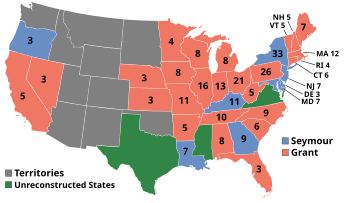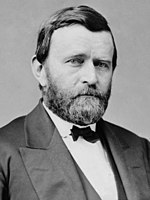
Back انتخابات الرئاسة الأمريكية 1868 Arabic ھەڵبژاردنی سەرۆکایەتیی ویلایەتە یەکگرتووەکانی ئەمریکا (١٨٦٨) CKB Præsidentvalget i USA 1868 Danish Präsidentschaftswahl in den Vereinigten Staaten 1868 German Elecciones presidenciales de Estados Unidos de 1868 Spanish Yhdysvaltain presidentinvaalit 1868 Finnish Élection présidentielle américaine de 1868 French הבחירות לנשיאות ארצות הברית 1868 HE Elezioni presidenziali negli Stati Uniti d'America del 1868 Italian 1868年アメリカ合衆国大統領選挙 Japanese
| |||||||||||||||||||||||||||||
294 members of the Electoral College 148 electoral votes needed to win | |||||||||||||||||||||||||||||
|---|---|---|---|---|---|---|---|---|---|---|---|---|---|---|---|---|---|---|---|---|---|---|---|---|---|---|---|---|---|
| Turnout | 80.9% [1] | ||||||||||||||||||||||||||||
| |||||||||||||||||||||||||||||
 Presidential election results map. Red denotes states won by Grant/Colfax, blue denotes those won by Seymour/Blair, and green denotes those states that had not yet been restored to the Union and which were therefore ineligible to vote. Numbers indicate the number of electoral votes allotted to each state. | |||||||||||||||||||||||||||||
| |||||||||||||||||||||||||||||
Presidential elections were held in the United States on November 3, 1868. In the first election of the Reconstruction Era, Republican nominee Ulysses S. Grant defeated Horatio Seymour of the Democratic Party. It was the first presidential election to take place after the conclusion of the American Civil War and the abolition of slavery. It was the first election in which African Americans could vote in the reconstructed Southern states, in accordance with the First Reconstruction Act.
Incumbent president Andrew Johnson had succeeded to the presidency in 1865 following the assassination of Abraham Lincoln, a Republican. Johnson, a War Democrat from Tennessee, had served as Lincoln's running mate in 1864 on the National Union ticket, which was designed to attract Republicans and War Democrats. Upon accession to office, Johnson clashed with the Republican Congress over Reconstruction policies and was impeached and nearly removed from office. Johnson received some support for another term at the 1868 Democratic National Convention, but, after several ballots, the convention nominated Seymour, who had formerly served as Governor of New York. The 1868 Republican National Convention unanimously nominated Grant, who had been the highest-ranking Union general at the end of the Civil War. The Democrats criticized the Republican Reconstruction policies, and "campaigned explicitly on an anti-black, pro-white platform,"[2] while Republicans campaigned on Grant's popularity and the Union victory in the Civil War.
Grant decisively won the electoral vote, but his margin was narrower in the popular vote. In addition to his appeal in the North, Grant benefited from votes among the newly enfranchised freedmen in the South, while the temporary political disfranchisement of many Southern whites helped Republican margins. As three of the former Confederate states (Texas, Mississippi, and Virginia) were not yet restored to the Union, their electors could not vote in the election. This was the last time that Missouri supported the Republican candidate until 1904. This was also the last time until 1912 that the Democrats carried more electoral votes from the North (46) than from the South (34), though this was partly due to extremely exceptional circumstances involving the Reconstruction, and in 1912 the reversal occurred due to the better Democratic performance nationwide as well as the higher population of the North. This was also the last time the Republicans did better in the popular vote in the South than in the North until 1964, again due to very large majorities in reconstruction states like South Carolina and Tennessee.
- ^ "National General Election VEP Turnout Rates, 1789–Present". United States Election Project. CQ Press.
- ^ Tali Mendelberg (2001), The Race Card: Campaign Strategy, Implicit Messages, and the Norm of Equality, Princeton University Press, pg. 45–46

